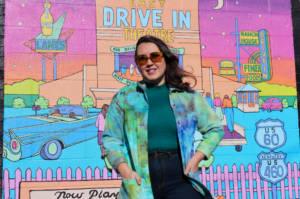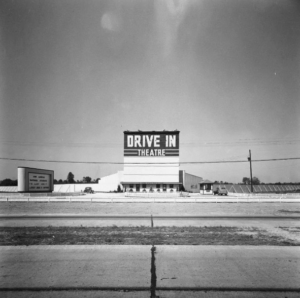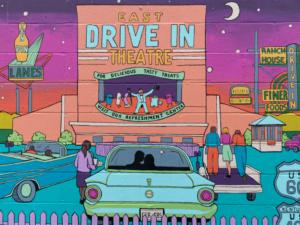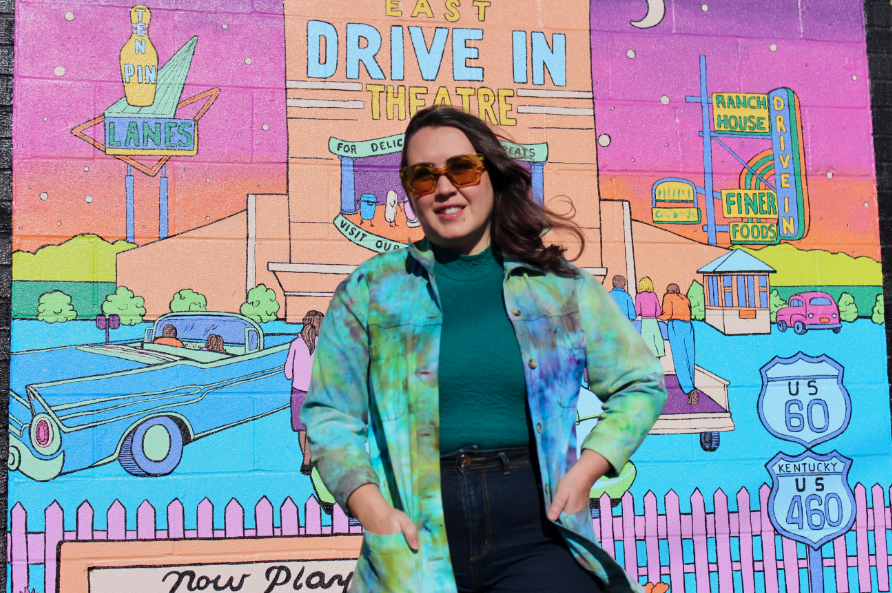A Look Back at the East Drive-In
Writer / Christy Heitger-Ewing
Photography Provided
 In the 1940s and 1950s, Jerry Shinbach was working for Howard Hughes, who owned a company called RKO that made films. Jerry worked for the indoor movie theater portion of RKO. In the late 1950s Jerry jumped into the outdoor movie business, purchasing three drive-in theaters in the Louisville area, including the East Drive-In.
In the 1940s and 1950s, Jerry Shinbach was working for Howard Hughes, who owned a company called RKO that made films. Jerry worked for the indoor movie theater portion of RKO. In the late 1950s Jerry jumped into the outdoor movie business, purchasing three drive-in theaters in the Louisville area, including the East Drive-In.
“He didn’t know much about drive-ins at the time, but he knew everything there was to know about indoor theaters,” says his son Bruce Shinbach, whose father continually pestered him to move to Louisville and partner with him in the business. Bruce, in his 20s and a Chicago stockbroker at the time, was happy on his life path, but his father was relentless.
“I came to Louisville in 1964 and fell in love with Louisville and the people who live here,” says Shinbach, who recalls the first day he was driving into Louisville from Chicago. “I got on 65 near Broadway and came to an intersection with heavy traffic. Being from Chicago, I thought it would take 20 minutes to merge into this line of traffic, but a car motioned me in right away. I thought, ‘Great Scott! That would never happen in Chicago!’ That was my first memory of being in Louisville.”
During that fateful year, he met a nice Kentucky girl named Edie, whom he married. He settled into life in the drive-in biz. One day in the early 1980s, Jerry called his son and said, “Your mother and I are retiring and moving to Florida. The business is all yours.”
It was essentially a “tag, you’re it” type of situation. Though Shinbach was stunned, he was ready for the torch to be passed because he loved the job.
“It was fun to feature a good Disney film and know that hundreds of cars were going to show up,” says Shinbach, who used to arrive at 7 a.m. on weekends to make tons of ice cream sundaes, which they put in the freezer so they would be ready for the evening show.
There was also excitement in getting a new film in and not knowing the kind of business it would generate. Selecting movies was part of the job. Shinbach hired bookers, who lived in bigger cities and screened nearly every movie that was made.
“I would go on their opinion of how good they thought the movie was and the revenues they would produce,” Shinbach says. “Every once in a while a booker would say, ‘I saw this movie and there are no big stars in it, but it’s one of the funniest films I’ve ever seen.’”
 Such was the case with the George Segal and Glenda Jackson film “A Touch of Class.”
Such was the case with the George Segal and Glenda Jackson film “A Touch of Class.”
“That was a huge hit,” Shinbach says. “So was the cowboy movie ‘Billy Jack.’”
Disney movies were always popular, as were Clint Eastwood films. The biggest blockbusters he can recall were “Jaws” and “Star Wars.” Sometimes they had dusk-to-dawn shows when they played horror films that started at midnight and ran until 4 a.m.
“They were terrible movies with lots of blood and guts, but kids loved them,” Shinbach says.
The East Drive-In employed a projectionist, a cashier, several concession workers, and two ushers who took tickets and patrolled the lot to make sure everyone was behaving. The biggest issue they had were teenagers who would cut speakers off posts and steal them. One night they found a bunch of speakers missing so they blocked the exits and alerted the authorities. Ultimately, they found the thief with 50 speakers in his trunk. The police called his father, who insisted that his son was a good boy who would never do such a thing.
“The officer told him, ‘Open the trunk,’” Shinbach says. “Once he did, the dad didn’t have much else to say.”
It wasn’t unusual for people to sneak into the facility in an effort to save a buck (well, maybe 85 cents). Many kids thought they were clever, but the drive-in staff was one step ahead.
“If a car came in with a driver and two persons in the backseat, and the rear of the vehicle was sitting 2” off the ground, you knew the guy had people in the trunk,” Shinbach says with a chuckle. The staff would charge the admission and let them in. Then they would almost always drive to the back row. The front gate would radio back to one of the ushers a description of the car and license plate. Then the usher would pull up next to that vehicle and wait.
“This was in the summer so it was very hot,” Shinbach says. “After 20 minutes you’d hear banging in the trunk and voices calling, ‘Get us out of here!’ Usually it was the driver’s girlfriend and somebody else. We just made them pay and let them stay.”
In 1966, when business started to wane, Shinbach tore down the theater to build a shopping center. Though it was a good move, he does have one regret, and it’s one his wife will never let him live down. When he was cleaning out space prior to the tear-down, he threw away all of the original movie posters – known as one sheets – that went in the display cases.
“I had ‘Star Wars,’ ‘Jaws’ and hundreds of others, and I threw every one of them out,” Shinbach says. “Had I saved them, years later, no telling what I could have sold them for to collectors.”
Last year the property managers of Best Buy (managed by Bilyeu Enterprises) commissioned artist Liz Richter to paint a 9’x9’ mural on the back of the building. They had always been enthused that this was the land where the drive-in once stood, and they wanted to commemorate the rich history of the property when Shelbyville Road was just open fields on either side and the Watterson Expressway was not yet constructed.
 “Those old enough to remember the theater do so with great nostalgia, and this work was to serve as a reminder of that special past life,” says Richter, who gathered as many historic photos and descriptions as she could and compiled them into one scene.
“Those old enough to remember the theater do so with great nostalgia, and this work was to serve as a reminder of that special past life,” says Richter, who gathered as many historic photos and descriptions as she could and compiled them into one scene.
“I focused on the nostalgic feel of a drive-in theater and built the composition around the large screen,” says Richter, who was drawn to the photos from the 1940s of this magical, huge, new mid-century structure in what looks like a pasture. “It was a symbol of St. Matthews farmland making a cultural shift into suburban or even metropolitan modernity. It was the beginning of a new era.”
Richter set the scene in the early 1960s and tried to fit in as many details as possible from the historic photos, such as the ticket booth, highway sign, picket fencing (it really was pink) and show board with two of the most popular movies that were shown, “Fantasia” and “The Sound of Music.”
“It’s a terrific portrayal of what the drive-in theater was,” says Shinbach, noting that the mural incorporates Bob Colglazier’s Ranch House, which sat on the corner of the drive-in. “They had a disc jockey every weekend so the kids would eat dinner there, stay for the music, then hit the drive-in afterwards.”
Back in the drive-in heyday, there were thousands of theaters all across the country. Today there are a few hundred, if that. Still, something special remains about drive-ins.
“People liked being out in the elements, watching a show on a huge screen with family and friends,” Shinbach says. “No need to get dressed up. You could take the kids with you and if they were crying or screaming, it didn’t matter much. Pickup trucks would come with kids in the back wearing pajamas, and they would back in with their speakers. It was lots of fun, and lots of great memories.”
To see more of Liz Richter’s artwork, visit lizrichterart.com.







Comments 1
My father, Ken Ulmer, was a projectionist at the East Drive In for many years, and friends with Bruce Shinback. I was born in 1964 so barely recall the drive-in, but all 5 of my older siblings have fond memories of this place.
Christi Ulmer